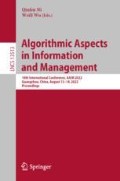Abstract
In consideration of most signed network embeddings only focusing on the low-order neighbors of the target node, they fail to make effective use of the high-order neighbors of the target node, and the link direction and sign of the node neighbors will affect the target node to varying degrees. Therefore, a SNEMA model using structure balance theory a multi head attention mechanism to aggregate high-order neighbors is proposed. The model gathers the information of high-order neighbors based on structural balance theory, captures node neighbors of different structure types through a multi head attention mechanism, obtains the low-dimensional feature vector representation of nodes through processing and learning, and applies the obtained network representation to the downstream task of link prediction. The experimental results on four real social network data sets show that the network representation obtained by the SNEMA model helps to improve the accuracy of link prediction, which shows that the SNEMA model has achieved better results in signed network representation learning.
Access this chapter
Tax calculation will be finalised at checkout
Purchases are for personal use only
References
O’Sullivan, D., Turner, A.: Visibility graphs and landscape visibility analysis. Int. J. Geogr. Inf. Sci. 15(3), 221–237 (2001)
Chen, J., Zhong, M., Li, J., Wang, D., Qian, T., Tu, H.: Effective deep attributed network representation learning with topology adapted smoothing. IEEE Trans. Cybern. https://doi.org/10.1109/TCYB.2021.3064092
Boccaletti, S., Ivanchenko, M., Latora, V., et al.: Detecting complex network modularity by dynamical clustering. Phys. Rev. E 75(4), 045102 (2007)
Tang, J., Chang, Y., Aggarwal, C., Liu, H.: A survey of signed network mining in social media. ACM Comput. Surv. (CSUR) 49(3), 42 (2016)
Zhang, Z., Cui, P., Zhu, W.: Deep learning on graphs: a survey. IEEE Trans. Knowl. Data Eng. (2020)
Zhang, D., Yin, J., Zhu, X., et al.: Network representation learning: a survey. IEEE Trans. Big Data 6(1), 3–28 (2018)
Zhou, J., Liu, L., Wei, W., et al.: Network representation learning: from preprocessing, feature extraction to node embedding. ACM Comput. Surv. (CSUR) 55(2), 1–35 (2022)
Perozzi, B., Al-Rfou, R., Skiena, S.: DeepWalk: online learning of social representations, pp. 701–710. ACM Press (2014). ACMSI GKDD, 855–864 (2016)
Veličković, P., Cucurull, G., Casanova, A., et al.: Graph attention networks. arXiv preprint arXiv:1710.10903 (2017)
Hamilton, W., Ying, Z., Leskovec, J.: Inductive representation learning on large graphs. In: Advances in Neural Information Processing Systems, pp. 1025–1035 (2017)
Yuan, S., Wu, X., Xiang, Y.: SNE: signed network embedding. In: Kim, J., Shim, K., Cao, L., Lee, JG., Lin, X., Moon, YS. (eds.) PAKDD 2017. LNCS, vol. 10235, pp. 183–195. Springer, Cham (2017). https://doi.org/10.1007/978-3-319-57529-2_15
Wang, S., Tang, J., Aggarwal, C., et al.: Signed network embedding in social media. In: Proceedings of SIAM International Conference on Data Mining, pp. 327–335. SIAM Press, Houston (2017)
Heider, F.: Attitudes and cognitive organization. J. Psychol. 21(1), 107–112 (1946)
Leskovec, J., Huttenlocher, D., Kleinberg, J.: Signed networks in social media. In: Proceedings of SIGCHI Conference on Human Factors in Computing Systems, pp. 1361–1370. ACM Press, New York (2010)
Girdhar, N., Bharadwaj, K.K.: Signed social networks: a survey. In: Singh, M., Gupta, P., Tyagi, V., Sharma, A., Ören, T., Grosky, W. (eds.) ICACDS 2016. CCIS, vol. 721, pp. 326–335. Springer, Singapore (2017). https://doi.org/10.1007/978-981-10-5427-3_35
Leskovec, J., Huttenlocher, D., Kleinberg, J.: Predicting positive and negative links in online social networks. In: Proceedings of the 19th International Conference on World Wide Web, pp. 641−650. ACM Press, New York (2010)
Chiang, K.Y., Natarajan, N., Tewari, A., et al.: Exploiting longer cycles for link prediction in signed networks. In: Proceedings of the 20th ACM International Conference on Information and Knowledge Management, pp. 1157–1162 (2011)
Vaswani, A., Shazeer, N., Parmar, N., et al.: Attention is all you need. In: Advances in Neural Information Processing Systems, vol. 30 (2017)
Acknowledgements
This work was supported by the National Science Foundation of China (Grant Nos. 62062001); This work was supported by the Ningxia first-class discipline and scientific research projects (electronic science and technology, NXYLXK2017A07); This work was supported by the Provincial Natural Science Foundation of NingXia (NZ17111, 2020AAC03219) and this work was supported by the scientific research platform of “Digital Agriculture Empowering Ningxia Rural Revitalization Innovation Team” of North Minzu University.
Author information
Authors and Affiliations
Corresponding author
Editor information
Editors and Affiliations
Rights and permissions
Copyright information
© 2022 The Author(s), under exclusive license to Springer Nature Switzerland AG
About this paper
Cite this paper
Lu, Z., Yu, Q., Wang, X., Li, X. (2022). Learning Signed Network Embedding via Muti-attention Mechanism. In: Ni, Q., Wu, W. (eds) Algorithmic Aspects in Information and Management. AAIM 2022. Lecture Notes in Computer Science, vol 13513. Springer, Cham. https://doi.org/10.1007/978-3-031-16081-3_39
Download citation
DOI: https://doi.org/10.1007/978-3-031-16081-3_39
Published:
Publisher Name: Springer, Cham
Print ISBN: 978-3-031-16080-6
Online ISBN: 978-3-031-16081-3
eBook Packages: Computer ScienceComputer Science (R0)

